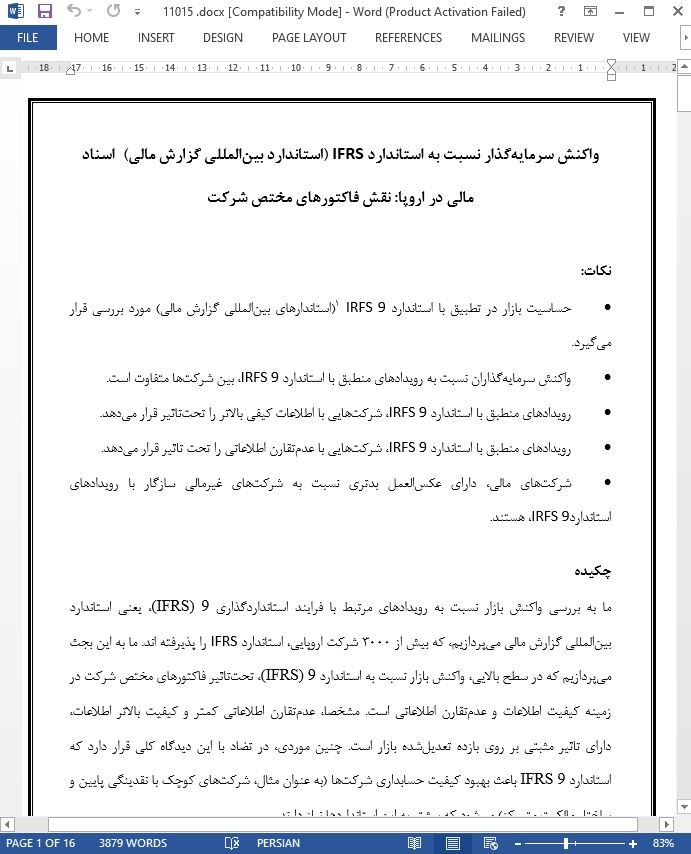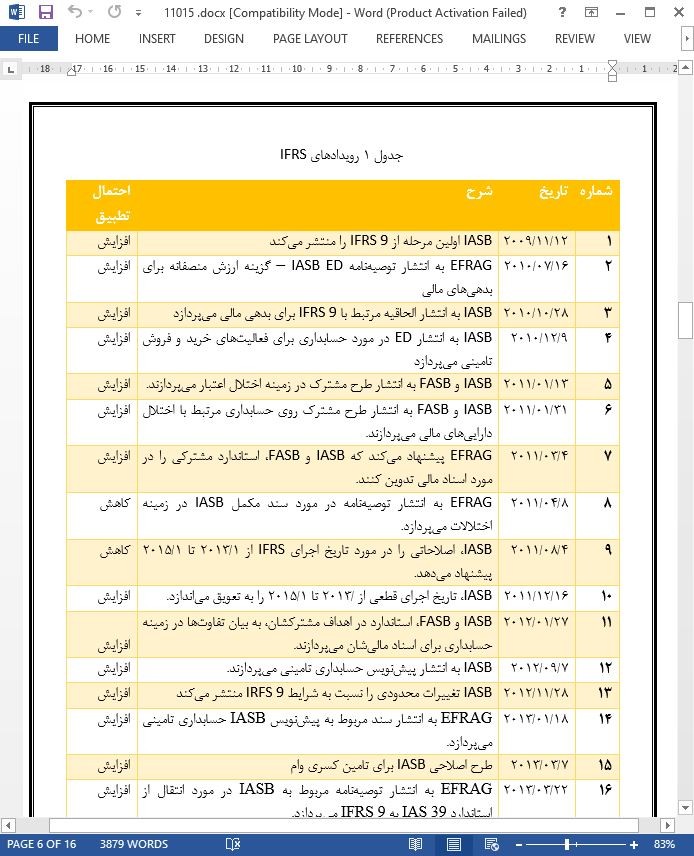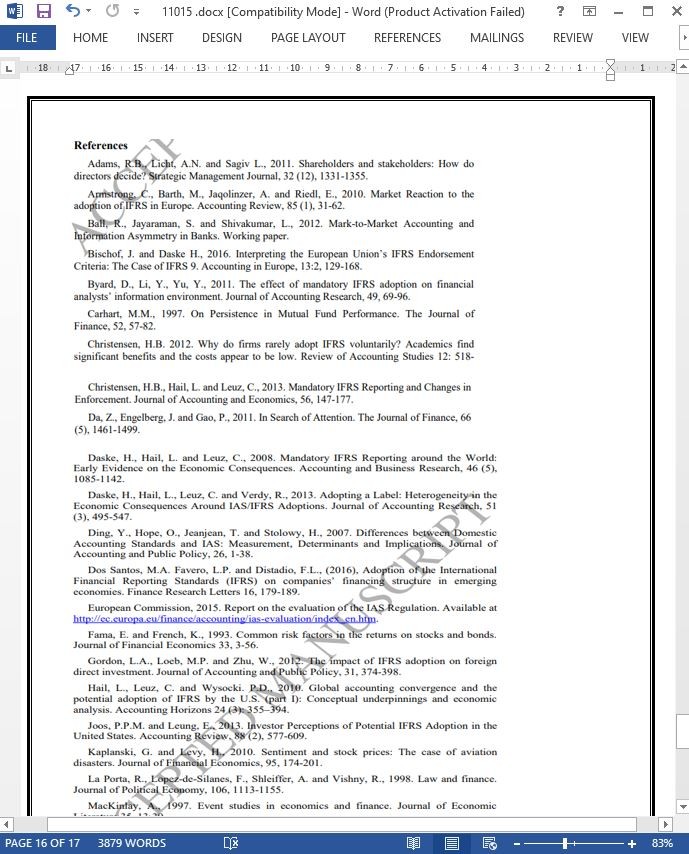
واکنش سرمایهگذار نسبت به استاندارد IFRS اسناد مالی در اروپا
چکیده
ما به بررسی واکنش بازار نسبت به رویدادهای مرتبط با فرایند استانداردگذاری (IFRS) 9، یعنی استاندارد بینالمللی گزارش مالی میپردازیم، که بیش از 3000 شرکت اروپایی، استاندارد IFRS را پذیرفته اند. ما به این بجث میپردازیم که در سطح بالایی، واکنش بازار نسبت به استاندارد (IFRS) 9، تحتتاثیر فاکتورهای مختص شرکت در زمینه کیفیت اطلاعات و عدمتقارن اطلاعاتی است. مشخصا، عدمتقارن اطلاعاتی کمتر و کیفیت بالاتر اطلاعات، دارای تاثیر مثبتی بر روی بازده تعدیلشده بازار است. چنین موردی، در تضاد با این دیدگاه کلی قرار دارد که استاندارد IFRS 9 باعث بهبود کیفیت حسابداری شرکتها (به عنوان مثال، شرکتهای کوچک با نقدینگی پایین و ساختار مالکیت متمرکز) میشود که بیشتر به این استانداردها نیاز دارند.
1. مقدمه
در 24 جولای 2014، هیئت استانداردهای حسابداری بینالمللی (IASB) ، معیار بینالمللی گزارش مالی (IRFS 9) را منتشر کرد- که یک سند مالی برای جایگزین کردن آن با استاندارد بینالمللی حسابداری (IAS) 39 است. معرفی استاندارد IFRS 9 در طی بحران مالی اخیر، توسط سازمانهای بینالمللی مختلفی، با هدف بهبود حسابداری برای اسناد مالی، درخواست شد (بیچوف و داسک، 2016) .
به دلیل اثرات بلقوه استاندار IFRS 9، روی کیفیت حسابداری، پرسش تجربی اینستکه آیا فاکتورهای مختص شرکت، درک سرمایهگذاران را در مورد قابلیت استاندارد IFRS 9 برای بالا بردن ارزش سهامداران، تحت تاثیر قرار میدهد.
5. نتیجه گیری
ما به مبحث واکنش سرمایهگذاران، براساس فرایند استانداردگذاری معیار IFRS (استاندارد بین المللی گزارش مالی) برای بیش از 3000 شرکت فهرستشده اروپایی پرداختیم.
پژوهش ما شواهد قوی و جدیدی را ارائه میدهد که کیفیت اطلاعت پیشتطبیقی بالاتر و عدم تقارن اطلاعات پیشتطبیقی پایینتر، دارای تاثیر مثبتی روی MAR است. بنابراین شواهد تجربی با حمایت از فرضیه 1 وجود دارد که براساس آن، واکنش سرمایهگذاران نسبت به استاندارد IFRS 9، تحت تاثیر فاکتور مختص شرکت قرار میگیرد. مشخصا، MAR به طور مثبتی مرتبط با اندازه، ساختار مالکیت پراکنده، نقدینگی بازار برای سهام شرکتی، و همچنین مرتبط با چهار شرکت حسابرسی بزرگ است. ما شواهدی را قراهم کردیم که شرکتهای مالی، دارای عکسالعمل نسبتا بدتری نسبت به شرکتهای غیرمالی دارای رویدادهای منطبق با استاندارد IFRS، هستند.
Abstract
We examine the market reaction to events related to the standard-setting process of International Financial Reporting Standard (IFRS) 9 for over 3,000 European firms that have adopted IFRS. We find that the market reaction to IFRS 9 is largely affected by firm-specific factors associated with information quality and information asymmetry. In particular, lower information asymmetry and higher information quality have a positive effect on market-adjusted returns. This is in conflict with the common view that IFRS 9 will improve accounting quality for those firms that need it most (namely, small firms with low liquidity and concentrated ownership structure).
1. Introduction
On July 24, 2014, the International Accounting Standards Board (IASB) released International Financial Reporting Standard (IFRS) 9 – Financial Instruments, to replace International Accounting Standard (IAS) 39. The introduction of IFRS 9 was solicited during the recent financial crisis by various international organizations, with the aim of improving accounting for financial instruments (Bischof and Daske, 2016).
Because of the potential impact of IFRS 9 on accounting quality, it is an empirical question whether firm-specific factors affect the investors’ perceptions about the ability of IFRS 9 to increase shareholder value.
5. Conclusions
We have investigated the investors’ reaction to the standard-setting process of IFRS 9 for over 3,000 European listed firms.
Our study offers novel and robust evidence that higher pre-adoption information quality and lower pre-adoption information asymmetry have a positive impact on the MAR. Thus, there is empirical evidence in favor of hypothesis H1, according to which the investors’ reaction to IFRS 9 is affected by firm-specific factors. In particular, the MAR is positively related with size, a dispersed ownership structure, market liquidity for the firm’s stock, and having a Big 4 auditor. We also provide evidence that financial firms react relatively worse than non-financial firms to the IFRS 9 adoption events.
نکات
چکیده
1. مقدمه
2. مرور پژوهشهای پیشین
3. روش بررسی و داده
3.1 فرضیه
3.2 روش
3.3 داده
4. نتایج
4.1 تستهای قوی
5. نتیجه گیری
Highlights
Abstract
1. Introduction
2. Literature review
3. Methodology and data
3.1. Hypothesis
3.2. Methodology
4. Results
4.1. Robustness tests
5. Conclusions
- اصل مقاله انگلیسی با فرمت ورد (word) با قابلیت ویرایش
- ترجمه فارسی مقاله با فرمت ورد (word) با قابلیت ویرایش، بدون آرم سایت ای ترجمه
- ترجمه فارسی مقاله با فرمت pdf، بدون آرم سایت ای ترجمه



